Agatha Christie was the first grown-up author I ever read. My mother was keen on her books and one day I picked one up, simply because it was lying about. I started to read it and discovered it was no more difficult then the Chalet School or Blue Door Theatre books which were my usual fare. Thus a bridge was crossed. I was probably 13. Thereafter I read most of AC’s novels and it would be another decade and a half before Dame Agatha died aged 86, in 1976 and the books stopped coming.
Of course there have been countless TV adaptations, films and stage plays, sequels and spin-offs based on the works of the woman who was outsold only by The Bible and Shakespeare and holds the record for being the best selling author of all time. But I hadn’t actually read an Agatha Christie book since I was a teenager. Time, then, to revisit one.
Published in 1957, 4.50 from Paddington, is based on the intriguing premise that in the few seconds two trains are level on parallel lines, an elderly woman witnesses a murder in the other train. I often think about it when, briefly, I can see into an adjacent train.
The plotting (which I had, of course, completely forgotten) is neat and tight. The witness tells her friend, Miss Marple what she has seen, and with the help of a nicely characterised young major domo (is there a female term for that?), who takes a job at a nearby big house, the search for a body is on. Most of the characters and suspects are part of, or connected to, the Crakenthorpe family who own said big house. They are, on the whole, a bunch of self-interested schemers although the long suffering daughter, Emma is nice and you hope desperately that she won’t turn out to be the “one what dunnit.” I’m not giving anything away for obvious reasons. Suffice it to say that, as nearly always with Dame Agatha – I worked out the formula very early in my reading journey – the murderer turns out to be the least likely person. She’s very good at smoke screens, unexpected twists, suspense and attention-holding.
I read this book partly with the intention of assessing the quality of the writing which I wouldn’t have noticed at all at 13 or 14. Today I come to it with a life time of reading – for pleasure, for study and for teaching purposes – behind me. My reading lens has changed.
And my goodness, what a pleasant surprise! She is almost as succinct and direct as Hemingway with lots of lovely short sentences and scant use of subordinate clauses. “Lucy obeyed the imperative finger. Old Mr Crakenthorpe took hold of her arm and pulled her inside the door and shut it.” Or: “Dr Quimper walked upstairs to his bedroom and started throwing off his clothes. He glanced at his watch. Five minutes past three. It had proved an unexpectedly tricky business bringing those twins into the world but all had gone well. He yawned. He was tired – very tired. He looked appreciatively at his bed.”
Her dialogue is pacey and free flowing too. Agatha Christie was also a successful (and some – witness The Mousetrap) and it shines clearly through the dynamic, rhythmic way she gets her characters talking.
She can also be very funny. I think my favourite sentence in the whole book is “Madame Joilet was a brisk business-like Frenchwoman with a shrewd eye, a small moustache, and a great deal of adipose tissue”. That’s a good example, Chaps, of zeugma and of the literary uses of a list of three. Oh sorry – I’m not in the classroom any more. Sometimes, I wish I were.

Next week on Susan’s Bookshelves: The Go-Between by Osman Yousefzada